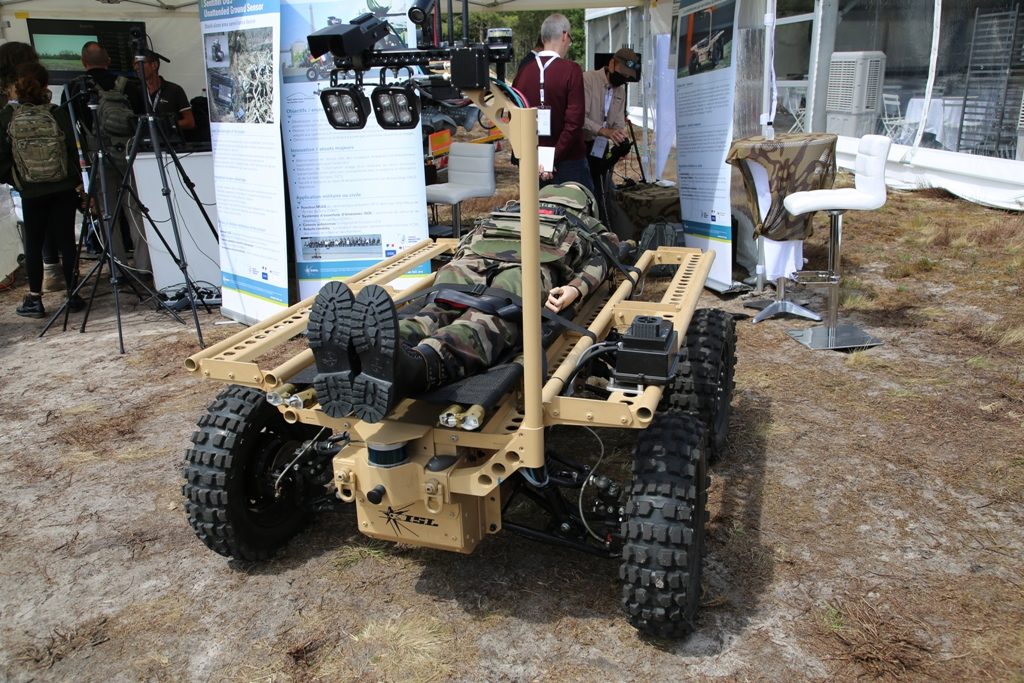
Stamina UGV Aurochs: a purposely-designed UGV from Institut Saint-Louis
Many UGVs are being developed in Europe, companies trying to get as close as possible to military requirements. These are in fact evolving as the UGV field is relatively novel, hence new missions emerge which bring with them new technical solutions.
The French-German Institut Saint-Louis (ISL), the research institute that falls under the auspices of the French DGA (Direction Générale pour l’Armement, General Directorate for Armament) and the German BAAINBw (BundesAmt für Ausrüstung, Informationstechnik und Nutzung der Bundeswehr, Federal Office of Bundeswehr Equipment, Information Technology and In-Service Support), developed a new UGV based on the needs expressed by the French EMAT (Etat Major de l’Armée de Terre, Army HQ) and the German Army PlgABw (Planungsamt der Bundeswehr, Bundeswehr Planning Office).
The STAMINA UGV Aurochs is a 4×4 platform fitted with fully independent suspensions and double steering axles that can carry up to two standard European pallets and can reach up to 50 km/h maximum speed, powered by electric drive wheels. The navigation system installed was also developed by the ISL; known as Stamina, hence the system name, it is designed to work in GPS-denied environments, and is based on a computer vision navigation-module allowing autonomous driving without drift and with very high accuracy, making the UGV suitable for operations in unstructured environments. The itinerary to be followed can be easily defined using a simple image sequence reducing image information to a small set of, metadata compatible with wireless communications between vehicles. This allows forwards and backwards autonomous driving, an obstacle avoiding module allowing also automatic return after avoiding obstacle.

The Aurochs can be used hand-free by an operator both in a “push me” mode; once the mode has been selected, any operator, without the need of any device, can modify speed and direction simply walking, or running, behind the Aurochs. EDR On-Line had the privilege to test the mode on the Camp de Souges testing ground and the mode is absolutely intuitive; if you want to steer the UGV towards the left you just have to move to the right, as you would do with your supermarket cart, and the other way round, while for changing speed you just have to stay behind the Aurochs and speed up your walk or stop abruptly, causing respectively the UGV to accelerate or stop.

Another requirement was the capability to operate the UGV at a longer range, without the need for the operator to concentrate on a command device, which impedes looking around searching for possible threats when operation in a tactical environment. The ISL thus developed a command module that is installed under the assault rifle barrel, in place of the 40 mm grenade launcher. Two commands are available, a joystick for steering the Aurochs on the left side, and one on the right that acts as accelerator/brake. The module is fully programmable, hence commands can be switched for left-handed operators.
The Aurochs UGV made it first full public appearance at SOFINS, the Special Operations Forces Innovation Network Seminar, organised by the Cèrcle de l’Arbalète at Camp de Souges, north of Bordeaux, after having been shown at the French Army “Force Vulcain” presentation on June 10th, the force being the Armée de Terre developmental tool for UGVs. A specific Vulcain section will be created at the CENTZUB, the French Army urban operations training centre at Sissonnes, while a Centre of Excellence (CoE) for Air-Ground Robotics will be formed at Satory. The latter will cooperate with industry, the ISL and the ONERA (Office National d’Études et de Recherches Aérospatiales, national aerospace studies and research centre) will be associated to that CoE.
The Aurochs was developed in close cooperation with the French Army Battle-Lab Terre, inaugurated in January 2021. The development will go on, a tougher and more powerful version with a 400-500 kg payload being planned. This will be capable to carry the rucksacks of a whole infantry firing team, made of eight soldiers, plus one littered casualty. Further uses are being developed, such as UGV-UGV cooperation, which is already well ahead, as well as the UGV-UAS cooperation, which according to ISL representatives is still at low TRL.

Beside the MULE and the CASEVAC role, the Aurochs can e used to deploy optronic sensors ahead of a unit, as well as to provide fire support, in an armed version. While its autonomy will continue to increase thanks to further developments in machine learning and artificial intelligence applications, it remains clear that the Aurochs UGV will always maintain a man in the loop.
Photos by P. Valpolini



